A Manager’s Guide to Dealing With Toxic Employees –…
transcript
Transcript
A Manager's Guide to Dealing With Toxic Employees
Here to read instead of watch? Click through the headings to a section of the full transcript, or scroll away!
- The Cost of Toxic Employees in Your Workplace (with Stats!)
- Toxic Employee Type #1 - The Steam Roller
- Toxic Employee Type #2 - The Social Loafer
- Toxic Employee Type #3 - The Ideas Thief
- Toxic Employee Type #4 - The Narcissist
- Toxic Employee Type #5 - The Abuser
- Toxic Employee Type #6 - The Bully-Victim
- How to Address Steam Roller Behaviour (with Examples!)
- How to Address Social Loafer Behaviour (with Examples!)
- How to Address Ideas Thief Behaviour (with Examples!)
- How to Address The Toxic Trio (Narcissist, Abuser & Bully-Victim) Behaviour
- Step 1: Proactivity
- Step 2: Investigations
- Step 3: Documentation
- What if Toxic Behaviour Has Spread Like a Weed?
- The 4 Options Your Employees Have When Faced with Toxic Behaviour
- Employee Option #1 - Resist & Resilience
- Employee Option #2 - Report
- Employee Option #3 - Relocation
- Employee Option #4 - Resign
- How to Cultivate a Positive Company Culture
(Edited for length and clarity)
Intro
Thank you so much, Holly, and to all of you at WIMDI for having me here to present to you tonight on A Manager's Guide to Dealing with Toxic Employees.
I am Julie Christiansen, and you're probably wondering, "Who the heck is this woman?" I'm an anger and communication expert. I'm a registered psychotherapist and an author, and an executive coach.
I live in the beautiful Niagara region of Ontario. I was asked, what are my food faves? And I have to say, I love the salty and the sweet.
My favourite, though, if you held a gun to my head and said, you know, "What do you really love?" I have to go for the chocolate-covered almonds every single time. Dark chocolate, absolutely my favourite.
I am an author. I've written 14 books. My bestselling book is called "The Rise of Rage." It just came out in February of 2024. I'm going to circle back to that at the end of our talk and give you some opportunities to engage with that book.
Leverage U, my company, is situated on the shared traditional lands of the Anishinaabe and the Haudenosaunee. We offer sincere gratitude to them as the stewards of this land, which is protected by the Dish with One Spoon Wampum Agreement's three principles.
I love these, so I want to share them with you. The Wampum Agreement's three principles are keep only what you need, leave enough for others, and always keep the dish clean.
Today, many First Nations, Métis, and Inuit communities from across Turtle Island continue to live and work in this territory.
Acknowledging the people whose territory we're on and the agreements that guide their stewardship of the land reminds us to reflect on and respect their unique relationship to this land.
It also is an invitation for all of us, and I love what Holly and WIMDI is doing in terms of giving back to your community.
It's an invitation for all of us to identify and engage in actions like those that respect and reinforce our commitment to truth and reconciliation in Indigenous rights in Canada and around the world.
We're going to tackle an issue that can silently or not so silently drain the energy, resources, and passion from your workplace. And that is toxic employees.
These individuals can wreak absolute havoc on your organisation, leading to high turnover, increase employee benefit costs, union disputes, wrongful dismissal lawsuits.
But beyond those tangible losses, perhaps the most damaging is the loss of peace and productivity in your team.
So today, what we're going to do is we're going to look at six types of toxic behaviours in the workplace, and then we'll equip you with some actionable strategies to detox that work environment and foster a healthier, more productive workplace.
The Cost of Toxic Employees in Your Workplace (with Stats!)
We will begin with the cost of toxicity. I want to share a couple of numbers with you that hopefully will not curl your hair completely, but they will give you something to think about as we move forward through this talk.
The first number is 12,506. This is estimated by Grammarly according to their research, I believe, that was done in 2022. The cost of poor communication and toxic behaviours to US businesses is $12,506 per employee per year. 12,506 per employee per year.
And here's another number that my curl your hair just a little bit more. The cost of poor communication and toxic behaviours, again, same Grammarly study, found that for companies with fewer than a hundred employees, the cost per company was $420,000 per year. That's average.
Some companies are losing more, some are losing less, but the average is 420,000 per year. Can your company afford to lose $420,000 per year? My company can't even afford to lose 12,000.
When you think of that and think about the types of toxic behaviours that show up in the workplace that contribute to this bleeding of funds, it shows us how important it is, if for no other reason than the bottom line, and hopefully we're not as mercenary as that.
It's important to weed out toxic employees from your workplace. Weeds can take over the whole garden if we don't nip them in the bud. Now, all it takes is one bad seed, right? One bad seed to poison a workplace.
Often that seed is indistinguishable from the other healthy seeds. Often, we don't even recognise the invasive weed until it's fully grown. And that may be a problem.
The good news is that it's really never too late to remediate a weed infestation. If negativity is a weed, what makes it grow?
Oh, I love this one, negative inner voice, and then listening to it. Yes, we don't have to listen to our inner voice if it's being negative, do we?
Managers who let complainers take over meetings. Attention to the negativity. Yeah, absolutely. Favouritism.
Blame. Yeah, these are all good. Neglect. Absolutely. Yeah. And along with the blaming and the complaining is the shaming, right?
Inertia within teams. Yeah. That lack of motivation, we're definitely going to hit on that tonight.
Not addressing it. Let's just pretend we're ostriches. We'll bury our heads in the sand and we won't pay attention.
When the psychological safety of a workplace is compromised, it is not good. Not good at all.
Everything that you've mentioned here in the chat can be grouped into different types of behaviours. So, we're going to look at those six types of toxic employees.
Toxic Employee Type #1 - The Steam Roller
We are going to begin with the steam roller. The steam roller is a know-it-all with bully tendencies. They tend to push, manipulate, or intimidate other people into going along with their point of view.
They often come up with really grand ideas, "Oh, I'm going to do this. And I think, you know, our department could do this, and it'll just push us to the top of the sales charts."
It's a great idea, or at least it sounds like a great idea, but it doesn't have a lot of substance. So they insist that those ideas ought to be implemented, but they don't really think through all of the details.
They're not thinking about how their ideas might impact other departments or how they might even impact members of the team.
Steam rollers stifle creativity and diversity of opinion, because if a steam roller gets to own the floor all the time and they're not kept in check, then what happens is the other people with creative ideas or contributions will hold them back.
So there's less diversity of opinion. And if they're successful in always pushing forward their agendas, people are going to check out.
It makes the organisation very one dimensional and it makes it less agile.
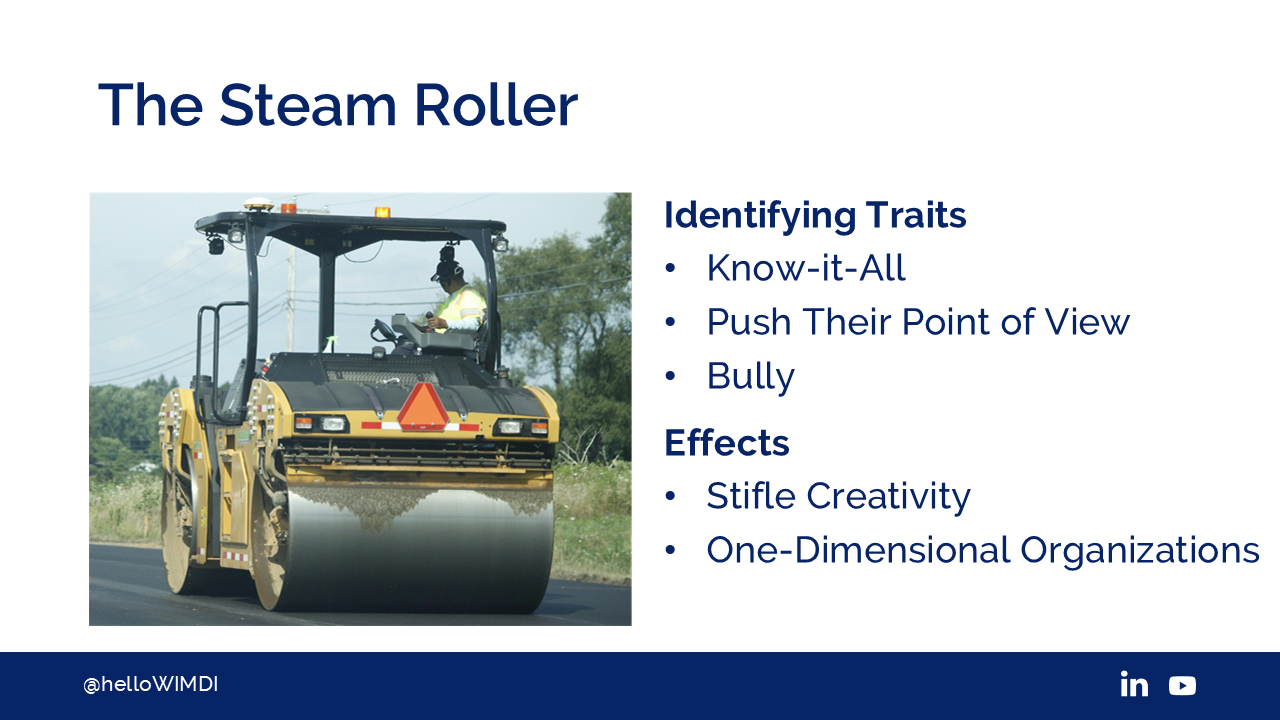
Toxic Employee Type #2 - The Social Loafer
Now, we have a social loafer. The social loafer is defined by simple psychology as the phenomenon where individuals exert less effort in a group or in a group task than when they're working alone.
This often occurs when there's a perception of reduced accountability or shared or diffused responsibility.
What I mean by that is shared/diffused responsibility happens when each individual team member's efforts are combined into a group project, it becomes more difficult to pinpoint the contributions of each member.
Then you get the idea that, because the responsibility is shared or diffused amongst all the members of the team, you can't really tell who's doing what.
The team gets rewarded, but certain people may just poop out. You know, they just check out.
They're not really engaged. They let everybody else do the work.
Social loafing results in resentment due to other workers feeling overwhelmed and sensing unfairness in the process because they're the ones taking up the slack of the loafers.
Since the work of the team is being judged rather than individual efforts, the more conscientious workers are going to feel responsible to do what's necessary to affect the positive outcomes.
So, they will feel overworked and unfairly rewarded while the social loafer feels gratified in having achieved this great outcome without having to do a whole lot of work.
Over time, social loafing can lead to reduced productivity and it leads to lower profits.
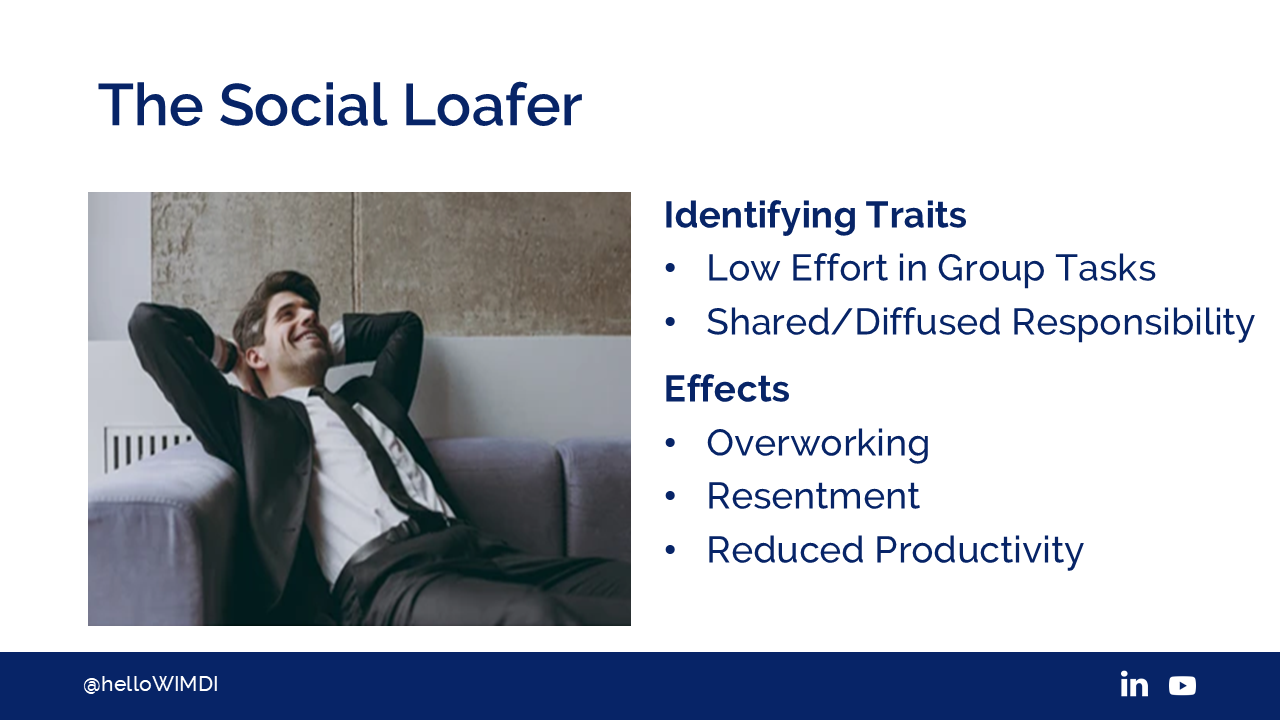
Toxic Employee Type #3 - The Ideas Thief
And then we have the ideas thief. This is typically someone who's in a position of power, more than likely middle to upper management, but sometimes it can also be a peer.
When a worker presents an idea that will help increase profits or help the company to run leaner, or they come up with something that will boost morale for the team, the ideas thief immediately dismisses the idea as inappropriate.
It's too expensive. It's too much work.
When sufficient time has passed, then the ideas thief will tweak the idea, they'll put their personal spin on it, and then they'll introduce the concept to the team and engage them with buy-in to move it forward, typically using the steam roller technique.
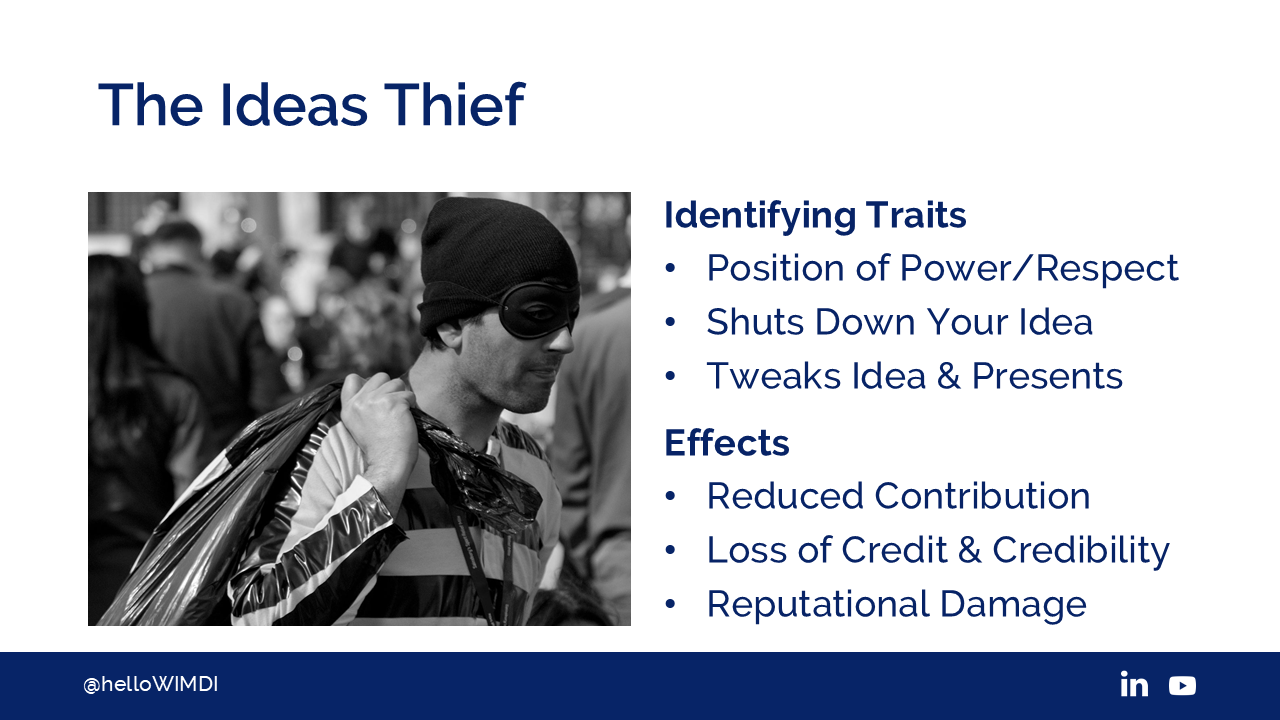
Toxic Employee Type #4 - The Narcissist
Let's talk about the narcissist. The narcissist is easily spotted as most of their communication is very me, me, me, egocentric in nature.
It primarily focuses on only the positive attributes. Look at how good I'm. Look at my numbers. You know, look at this project I just did. "Oh, hey, I just took a call and the customer was really happy."
It's always me, me, me. Narcissists are fueled by praise and adoration. They're very self-aggrandizing.
When they see other people succeed or perform admirably, it sparks a sense of insecurity or inadequacy in the narcissist.
And they respond by trying to make themselves appear bigger or more successful. They do that by making their perceived rival appear smaller, or less competent.
Now, any criticism, however constructive, to the narcissist is quickly turned back on the one offering it. Any attempts to call the narcissist on their behaviour is met with gaslighting or minimization.
What happens is peers and supervisors feel very frustrated. They feel helpless. They get resentful towards the narcissist.
And because narcissists are all about themselves, they are so hard to work with. People will shy away from having to collaborate with them.
Eventually, team cohesion really erodes and just falls apart if the narcissist is allowed to continue without being checked.
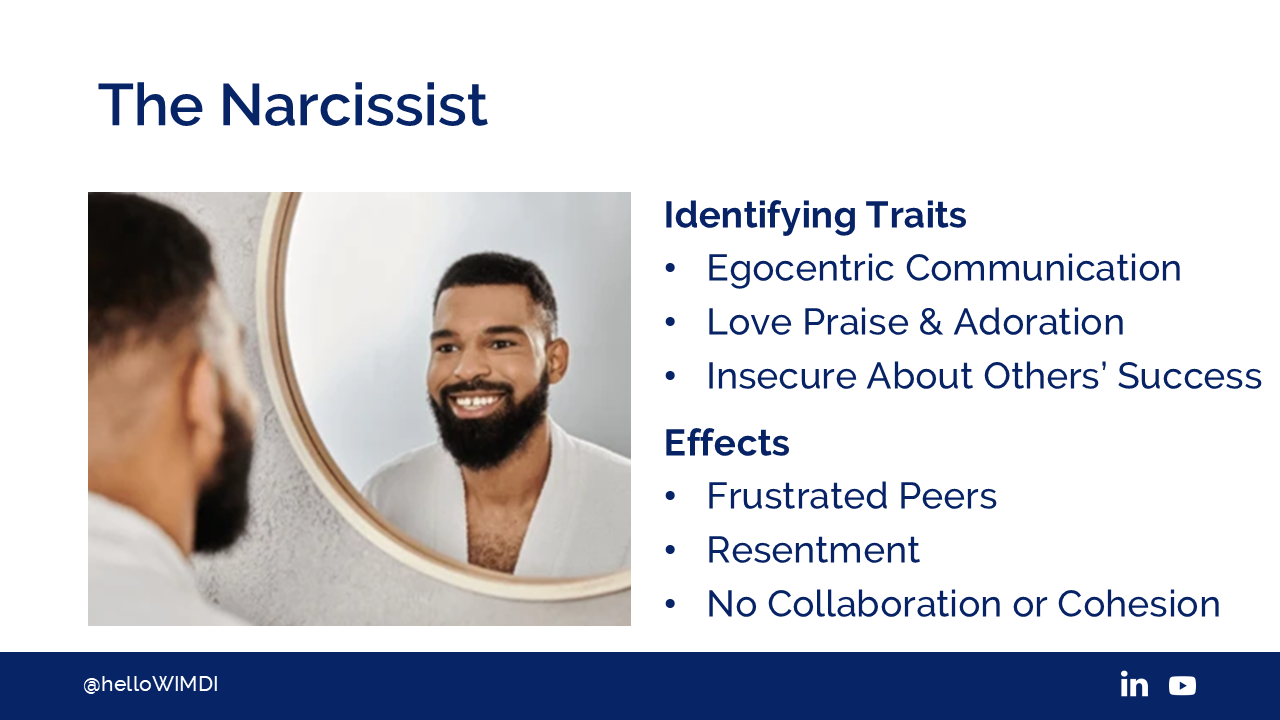
Toxic Employee Type #5 - The Abuser
And we have the abuser. The word abuse comes from the Latin ab and use. Ab means to take away. Use is the Latin word for power. So, to abuse someone is to systematically take away their power.
Now, perhaps somebody in your workplace takes credit for your work or speaks over you in meetings or monopolises the floor.
They say things like, "Oh, you know, we've run out of time. We'll get to your issues at the next meeting."
Perhaps they're influential in policy making. Maybe they bend procedures so that it works in their favour, but not in yours.
Someone the other day told me that she asked to work from home two days a week, and her manager said, "No, you're client-facing. We need you here in the office."
When she reaches out to the supervisor and says, "I need some help from you," the supervisor says, "Oh, that's too bad. I'm not coming in today. I'm working from home."
You know that kind of thing. So, it's like, "Okay, so procedure will work in my favour, but not in yours."
Maybe the abuser has the ear of the decision-maker and they use lies and manipulations to suggest that you're overwhelmed or incapable of handling your responsibilities. They need to be shifted to the abuser.
Sometimes abuse can be very subtle and very subversive. It can be more overt as well.
There's the snide remarks, the insults, the backhanded compliment, the eye rolling, assigning meaningless tasks, social or professional isolation. And sometimes it does escalate into physical abuse even in the workplace.
It's important to note that not all narcissists are abusers. When abusive behaviour is coupled with narcissistic personality and a victim mentality, this could very possibly be the worst type of toxic worker.
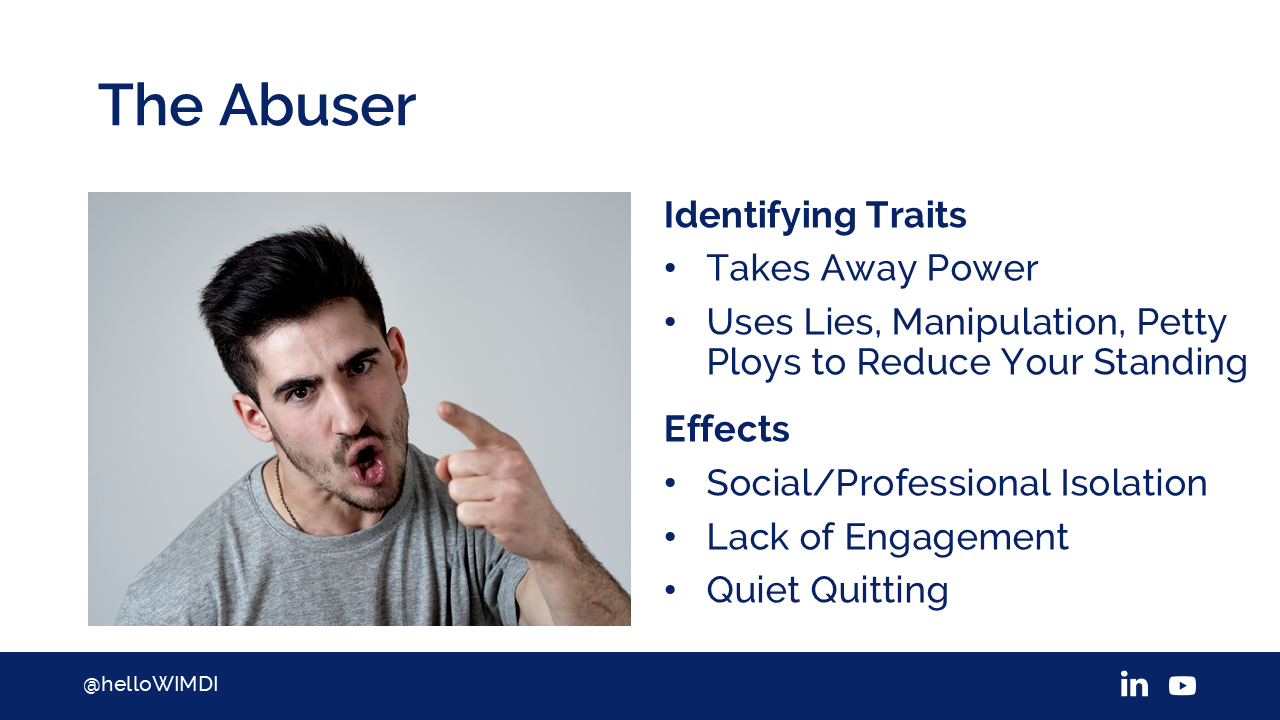
Toxic Employee Type #6 - The Bully-Victim
That brings us to that type, which is the bully-victim. When an abuser has free reign in the workplace, it may result in social and professional isolation of the target.
Bullies can be highly effective at convincing peers and managers that the target is the problem. They can say, "Oh, well, that person deserves to be treated that way." They deserve to be ignored, belittled, reprimanded, or demoted.
One of the cautions I would offer before we get to the bully-victim, is that managers must be careful to employ their critical thinking skills and remain objective. Don't get sucked into the narrative, especially when one person is leading the charge to discredit the target.
The long-term effects of having an abusive employee: There's a lack of engagement from those targeted by the bullying behaviour. Those targeted will go into survival mode.
They will engage in quiet quitting, which means they'll do only the bare minimum to keep their job because the rest of their brain, frankly, their capacity is going to be dedicated to managing the attacks from the bully.
They won't have the capacity to take on extra stuff. They won't be able to remember that thing that they promised they would do because they're in fight or flight. They're in survival mode.
When you see productivity starting to go down, when you see people starting to be stressed out by even the slightest little thing, it's probably a good time to check in.
Let's talk about the bully-victim. Often this is the narcissist with abuser traits. They fall into this bully-victim category.
Let's be clear that the people who are targeted by toxic employees, they are the true victims, okay?
However, the bully-victim is the one who creates relationship problems and then who cries foul. You know, when they're called on their behaviour, then they're like, "Oh, I can't believe it." Right?
The crocodile tears come out.
The bully-victim can be highly manipulative and may often be successful at convincing management and HR that they're innocent of all the accusations against them.
This results in punitive action being taken against the one who lodged the complaint. Because of this, many employers lose their best and brightest, their most productive employees who would just rather honestly move on and try to fight for fair treatment in the current work environment.
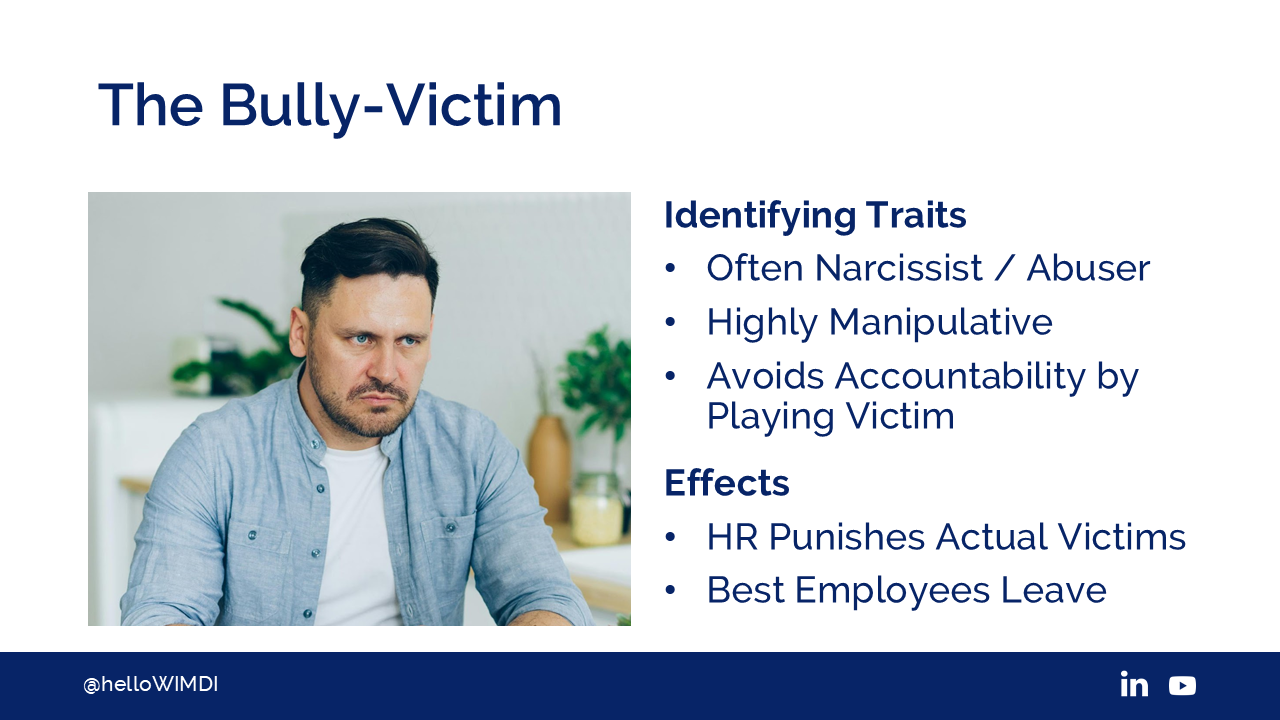
How to Address Steam Roller Behaviour (with Examples!)
Now that we know what these toxic, poisonous behaviours are, what do we do about it? How can we intervene and start to stem the tide and start to pull the weeds?
When we're talking about the steam roller, the key thing is to coach instead of challenge. It's easy to challenge someone and be like, "Oh my gosh. Can you just stop talking for one second and let's hear everybody else out who wants to share all the ideas?"
But they're going to become defensive, and they're going to argue as to why their idea is right. It's important to remember that steam rollers often deliver a lot of bluster for their ideas, but very often those ideas are short on substance.
Decisions that affect the bottom line and employee morale should never be made because one person shouted louder than everybody else.
So ultimately, it's the leader's role to ensure that this doesn't happen. So how do we do this?
I suggest posing questions as though they came from a third party. And this ensures that the steam roller will not attempt to derail the debate by attacking you.
Rather without a specific person on whom to focus all that belligerence and bluster, they get redirected to the issues instead and they have to devise intelligent responses to the questions.
One of my mantras is always focus on the problem, not the person.
This strategy is called the third-party intervener. How does this work? Rather than openly pointing out the challenges with the steam rollers ideas, because this will cause them to lose face, and it might result in them taking the bluster up a notch, you know?
Rather than doing that, we use a coaching approach, and we ask questions, but we ensure that the questions are always posed from the point of view of a third party.
So instead of just saying, "Well, you know, I want to know," we would frame it like this.
"What if someone asked you..."
So that's always kind of like your softener.
"What if someone asked you, if we follow through with the plan as you designed it, what will happen if," and then you list off the contingencies, right?
Or you might say, "What if someone asked you, where would we get the resources, the money, the staff, to complete this project on time and under budget?"
And you're always making sure it's someone asking the question, not you. When you ask intelligent, detailed questions and you remain focused on the problem rather than attacking the person, they won't have a choice but to reconsider their own ideas.
If the idea has merit, but it lacks the details and the logistics, they will have to go back to the drawing board and figure that stuff out.
While they're sorting out those missing pieces, then you can take the other contributions from your other employees and put them back on the table for further exploration.
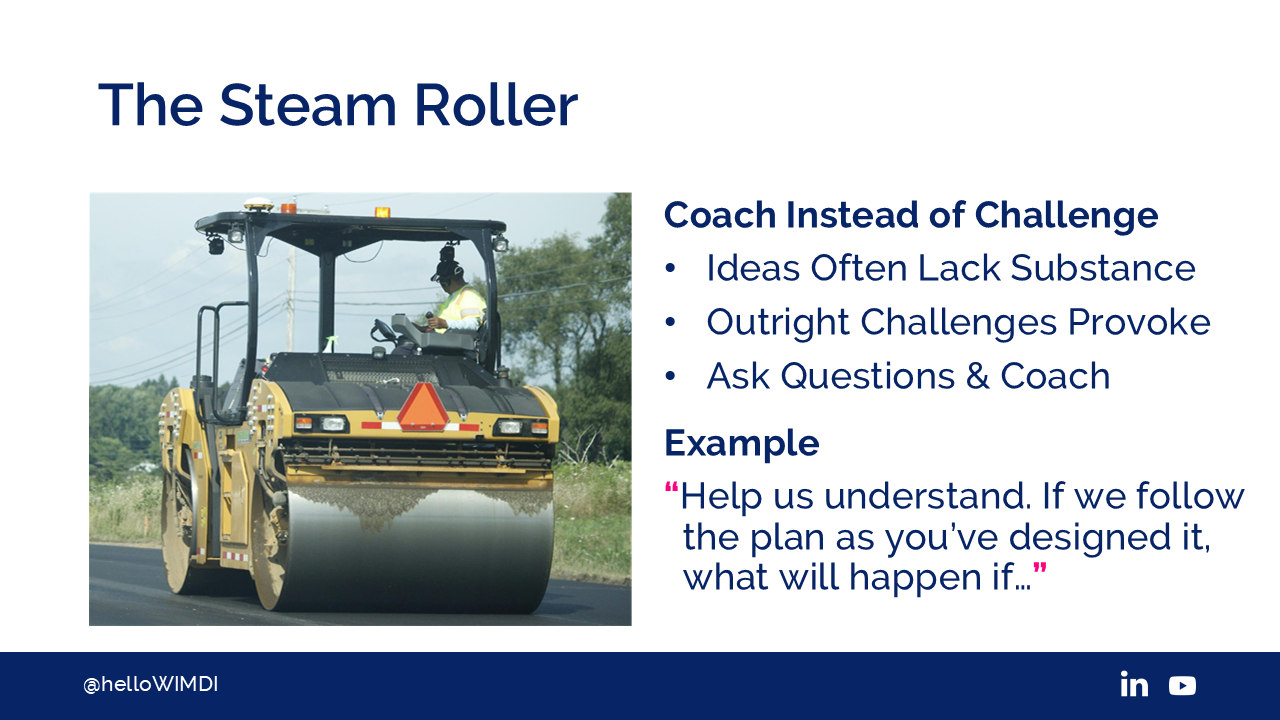
How to Address Social Loafer Behaviour (with Examples!)
When we're dealing with this social loafer, the keyword is accountability.
When assigning projects to teams, leaders have got to be mindful of those who stay late and those who do more than their fair share of the work, as well as those who always appear to be very busy, or the ones that are always saying, "Oh, I have so much work. I'm so busy. I couldn't possibly take on something else because I'm so overwhelmed."
If there's no proof of their productivity, if you're not seeing results, but they're constantly going on about how busy they are, pay attention.
A social loafer is going to need a few gentle reminders. They don't need to be micromanaged. Nobody loves to be micromanaged, but they may need a few gentle reminders, a few nudges to stay on top of their work.
It may be worthwhile to check in with the team, intermittently, to make sure that nobody's being overtaxed or taking on more than their share of work.
Instead of putting together and speaking to the group, you know, like when we're going to assign a new task, we're going to just pull the whole group together and say, "Here's the project. I want you guys all to work on this."
Instead of doing that, let them know that they're working on a project together, but then assign specific tasks to each participant.
You identify the strengths that they have and that you've noticed in them. And let them know why you trust them with that particular task or with that particular role.
You state your expectations for each team member clearly. And make sure that you reward everyone separately for their contribution, as well as congratulating the entire team when the project is complete.
This way people know that they can't get away with that diffused responsibility, because they have very specific tasks that they will be expected to complete.
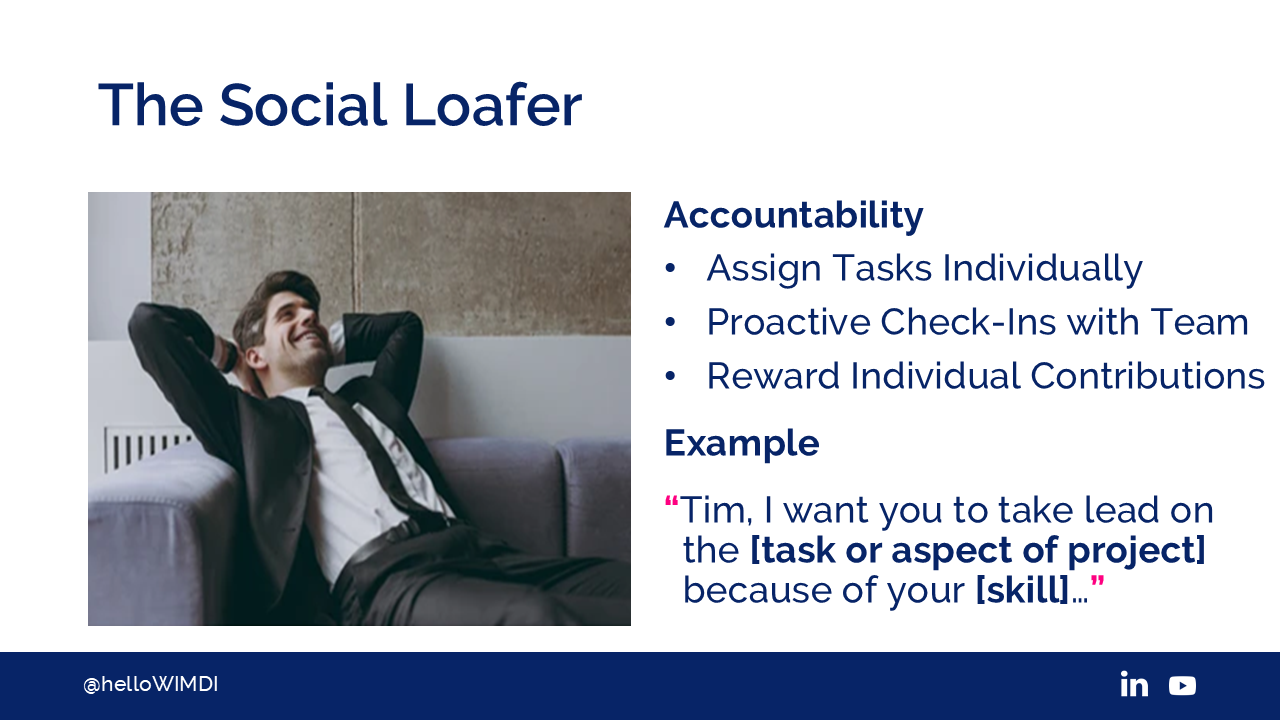
How to Address Ideas Thief Behaviour (with Examples!)
When we're working with the ideas thief, what do we do? It's important to implement a system, managers, that ensures that your team members are given credit for their ideas. So now accountability falls to the managers.
Encourage employees to document their ideas. Date stamp their written communications about their ideas.
I always encourage people, never, ever, ever share an idea just verbally if you want to receive credit for it. Make sure that you've documented it and that you've stamped it, and that there's a paper trail that shows that you originated that idea.
Give credit where it's due, managers. Acknowledge when great ideas come across your desk. Share with the team. Make sure everyone knows where that idea originated.
It's really important that managers hold themselves accountable and keep their agreements. When you say you're going to do something, follow through, because employees have really long memories, and if an idea of theirs is stolen or agreements are not kept, they will remember.
You'll see it in the effects of lower engagement by quitting or lateral transfer.
And if someone comes forward with an idea that you know has originated elsewhere, bring them into the discussion.
When I say them, I mean, bring the original person who brought the idea forward first. Bring their name into the discussion.
You can do this in a really gentle way by saying something like this, "Thank you so much for bringing this forward. You know, it's really interesting that Holly suggested this very same idea some weeks ago. So let me loop her into the conversation and we'll circle back around to it. We can all sit down and talk about it. It seems like great minds are thinking alike, right? Let's pull us all together and let's talk about it."
So that way it's not, "Well, Holly already told me about this. It sounds like you're just trying to steal her work."
No, we're not going to say that. But we can do it very gently and let them know that this has already been presented. So, thank you for sharing, but we know who the originator is.
How to Address The Toxic Trio (Narcissist, Abuser & Bully-Victim) Behaviour
Then we have what we'll call the toxic trio: the narcissist, the bully-victim, and the abuser. We have some very clear strategies that we want to share for these.
So, the key things for the toxic trio:
Number one is proactivity.
Number two is investigations.
And number three is documentation.
Employers, HR managers, and leaders, I plead with you. You have a responsibility to do what is necessary to support your productive, high-performing employees and to remediate the toxic behaviours before they poison your work environment.
Step 1: Proactivity
Proactivity is not the same as micromanagement. I can't stress that enough. Exerting too much control over the day-to-day runs counter to cultivating that peaceful, highly productive workplace.
When employees feel like their every move is being monitored and critiqued, it creates this atmosphere that's rife with stress and anxiety, and people will just disengage.
If I'm not doing that, I can't be criticised for it. They'll pull back. Lower productivity becomes a result, and ultimately, you'll see a decline in your profits.
Proactivity means being engaged and being aware of what is happening on the floor in real time. There are people who give feedback based on things that they were told, not on things they observe. And we can tell the difference as employees.
I know it's easy for managers or leaders to get caught up in their own workload. It's easy to just say, "I'm just going to keep my head down, dodge the bullets, take care of my own work."
They ignore the day-to-day activities in the workplace. But the thing is that the completely hands-off approach leaves room for weeds of negativity and toxicity to take hold and choke out morale and damage your bottom line.
To the last point in this list that talks about metrics and measures and outcomes, the bully-victim may complain that, you know, "I have so much work to do. I'm too busy to help anybody else."
But if the metrics don't bear that out, once you can produce numbers demonstrating a disconnect between their claims and the metrics, you can discuss ways that they can be more efficient in completing the tasks.
We discussed this so much in prepping for this presentation about how so many companies collect metrics, but then they don't review them. What good are they?
We'd look at the numbers and say, "Well, this person is outperforming everyone else, but here we have people who are performing less. They're doing poorer quality of work and they're getting paid more."
Perhaps we should reward performance rather than seniority or some other artificial construct. These are ways that we can help to keep people accountable without falling into the trap of micromanagement.
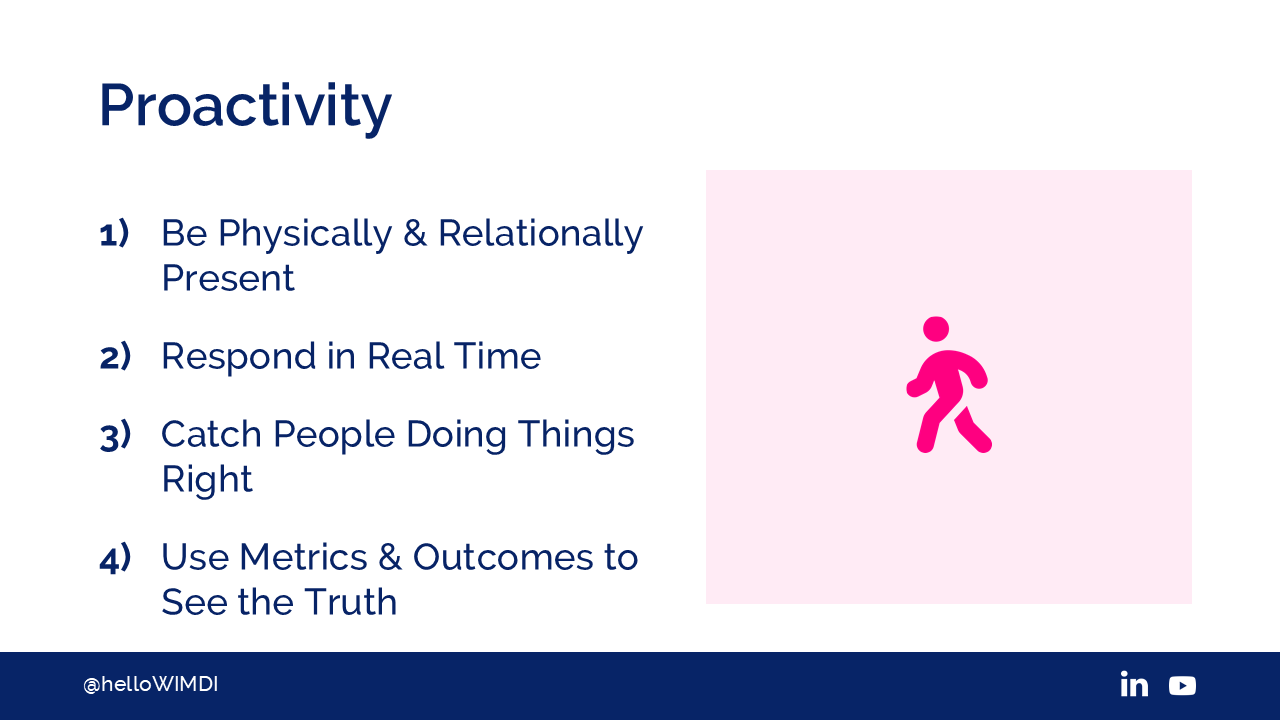
Step 2: Investigations
My grade 13 English teacher always used to say, "When in doubt, check it out." Right? When in doubt, check it out.
Investigations are so important. They need to be fair. They need to be thorough. Employees need to feel heard. They need to feel validated that somebody understands their complaints.
It doesn't mean that you agree with them. It doesn't mean that you're just going to arbitrarily punish other people, but you've got to validate how people feel.
Attention has to be paid to what is happening on the floor. And when questionable behaviours occur, you can jump in and ask clarifying questions. Approach each situation without bias or prejudice.
For example, if you see two people, they look like they're in a heated discussion, there's nothing wrong with going, "Is everything okay here? Do you guys need some help?"
Just stepping in as a person willing to support will deter the bully from pushing forward their agenda, but it also rescues the target from that engagement.
It also lets people know that you're watching, you're paying attention. It acts as a deterrent from those types of toxic behaviours.
There's no need to be accusatory when you're investigating, but certainly, you know, you can check in. It's a simple and non-confrontational way to hold people accountable for those communications in the office.
When an employee makes a claim of bullying or harassment, please take it seriously. So many times, I hear this in the school room and in the boardroom, this question, "Well, what did you do?"
You know, "What did you do?" Like you deserved it. We need to remove that question from our vocabulary, because it causes feelings of self-blame for the target.
Rather you can ask, "Well, when that happened, how did you respond? Were there witnesses? How often has this happened? Did you ask that person to stop that behaviour?"
And most importantly, because this is what's going to impact your bottom line, "How have these interactions with this person impacted your ability to do your job?" This is a good question.
The other question you want to ask is, "How do you feel about yourself? And how do you feel about working here because of what's been going on?"
Investigations must go beyond asking questions of the target and the person accused of the toxic behaviour. This is really important too. You've got to speak to witnesses.
I cannot tell you how many people have come through my practise who have launched complaints against bullies and when WSIB steps in to investigate, the employer says, "Yes, we're going to interview all the witnesses. We're going to talk to everybody."
And then they come back, and they say, "Well, there's no evidence that this actually happened."
Then when you press them, you find out that they never actually interviewed anyone. Scary, right? Here's the other thing. There are cameras everywhere. Everyone's got a camera in their hand.
There are security cameras. If those security cams might have recorded the incident, watch the tape, watch the recording. It doesn't take a lot of time. Just watch it.
Ensure that the people who witnessed the events feel safe in coming forward. Because a lot of time, you're going to see that witnesses will say, "Well, I don't want to get involved," because they don't want to be targeted by a bully.
If your organisation has a reputation for punishing the people who call out toxic behaviours rather than punishing those that are engaging in toxic behaviours, and maybe I shouldn't use the word punish, but consequencing the people who are engaging in toxic behaviours, nobody will feel safe to report.
What you'll see instead is an exodus of really great workers from your workplace.
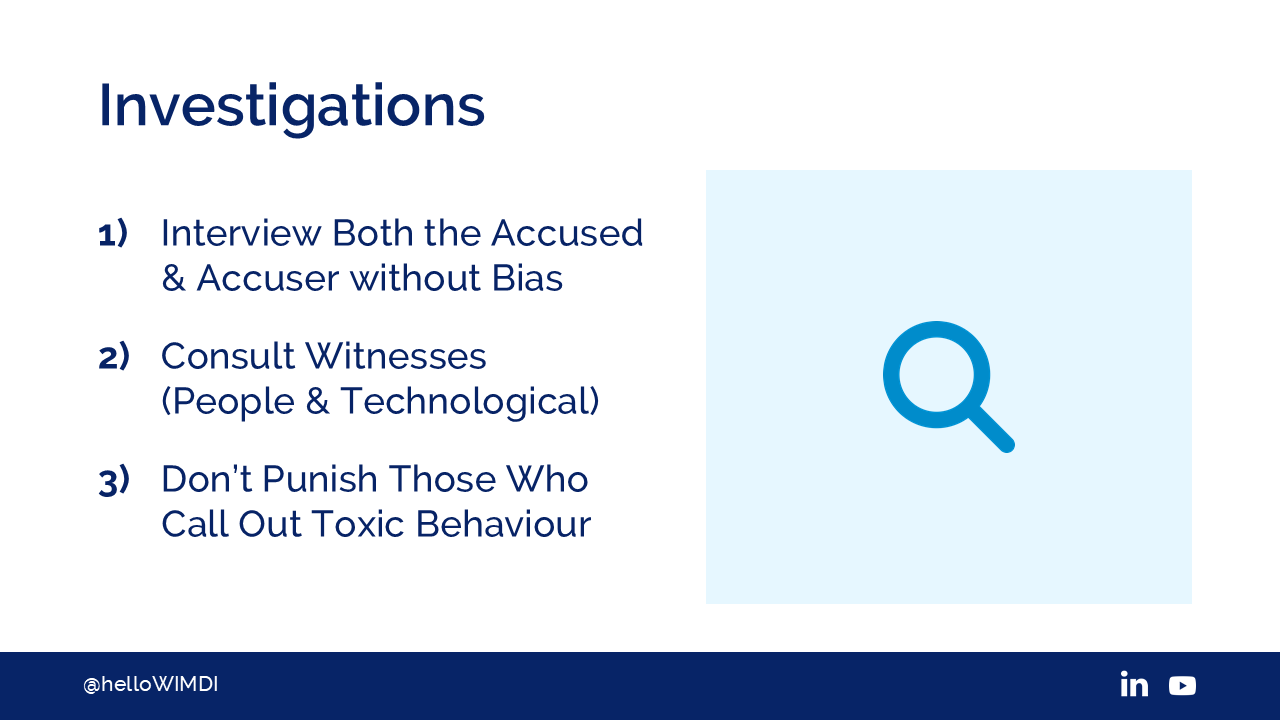
Step 3: Documentation
Finally, documentation. Managers and HR professionals have a duty to record and document complaints and to investigate them fully and fairly.
I've been doing some research on school violence, and I read an article today that was put out by the CBC that said that the majority of schools in Ontario are failing to report incidents of aggression and violence in their schools to the ministry.
And they're mandated to do it. They're liable if they don't. But they're afraid that if they do report, then they'll get labelled as a violent school, people won't want to enrol their students, and then they'll lose funding.
I think a lot of workplaces might be like this as well, that it's like, "Well, if I don't write it down, it didn't happen." Documentation is key.
Ensure that you document conversations, arguments, aggressions or confrontations in detail if you witnessed them and ask your employees to do the same.
You want to ask:
- When did it happen?
- Where did it happen?
- Who was present?
- Did anyone attempt to intervene?
- Is there any physical evidence of the encounter?
- Does the employee have records of doctor's appointments and the physician's findings?
- Has the employee experienced health problems and excessive anxiety or stress because of it?
All of this information will be important to follow up on or to launch an investigation.
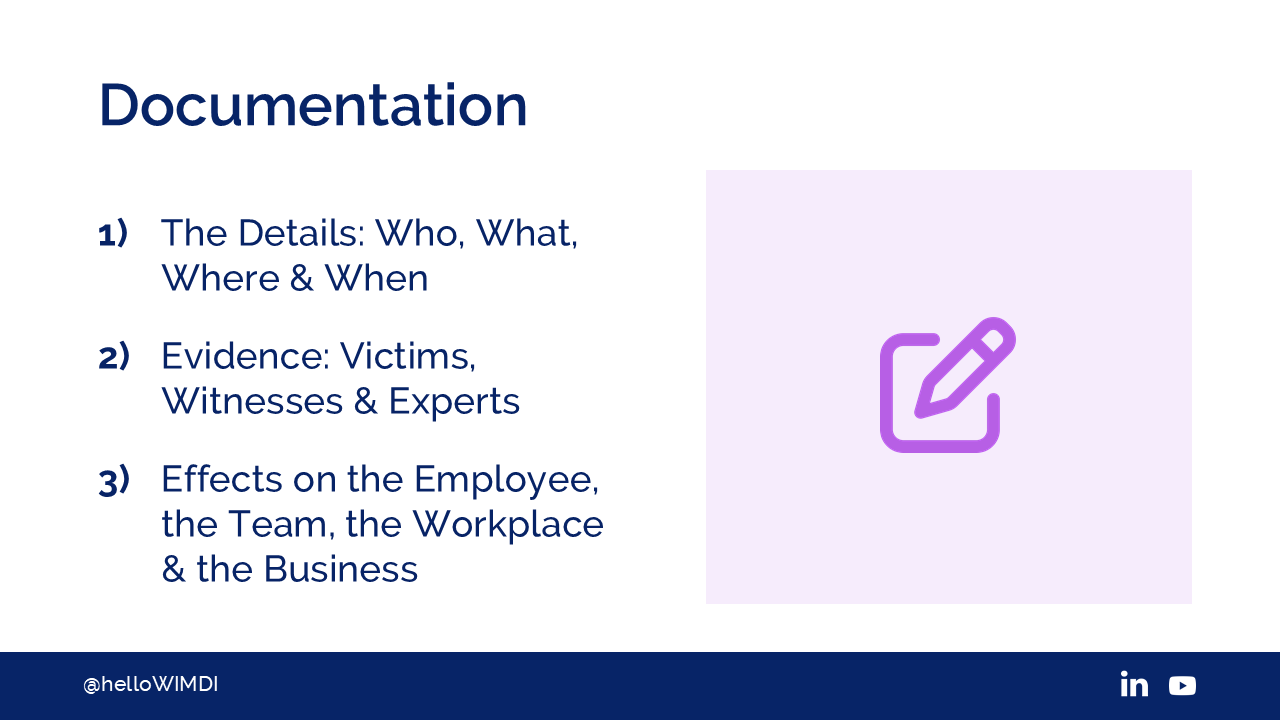
What if Toxic Behaviour Has Spread Like a Weed?
The next question is: What if you're not successful? What if the weeds have fully bloomed and now they've gone to seed, and now it's spreading like wildfire through your workplace?
All the beautiful flowers you were trying to grow, that is your employees, they'll either get burned out, or worse, they'll die. In other words, they will leave. They will just walk away from your organisation.
The 4 Options Your Employees Have When Faced with Toxic Behaviour
If you're unable to get ahead of toxic behaviours, your employees are going to have four options.
There's resistance, there's reporting, relocation, and resignation.

Employee Option #1 - Resist & Resilience
The first line of defence when dealing with toxic employees is resistance. Resistance sometimes looks like defending oneself, calling out unacceptable language or behaviour, using documentation as a way to protect oneself from unwarranted claims.
A subtler form of resistance is resilience. And I love that statement that resilience is resistance.
I'll give you the five pillars and I'll do it very slowly. There are five pillars of resilience.
Number one is self-awareness.
Number two is mindfulness.
The third is self-care.
The fourth is positive relationships.
Now I want you to remember this because bullies, steam rollers, narcissists, abusers, bully-victims are very good at breaking up relationships in the work environment and socially isolating the target.
So, if positive relationships is a form of resistance, because it is resilience, that's the first thing that people will try to break down. When you see people becoming isolated at work, pay attention and see if you can intervene.
The last is purpose.
So when someone loses their sense of purpose at work because the bully or the abuser has taken away their power, has taken away the significance of their role, has left them in a position where they have a job title of junior manager, but they have no subordinates because all of those have been pulled away to different departments, or they're being given insignificant tasks, they're losing their sense of purpose.
We can help to provide those things within the workplace for them to help them remain resilient. But I also want to say that even the most resilient of employees will eventually buckle under the weight of abuse.
So, it's your responsibility to ensure that this doesn't happen.
Employee Option #2 - Report
The next step up is reporting. Sometimes resistance and resilience are not enough to stop toxic behaviours from happening.
When it reaches that tipping point, the targeted employee may decide to report. They may take their complaints to HR, they may go to management, or if the workplace is unionised, they might speak to their union rep to determine the best way to proceed.
You need to do your due diligence so that the complaint or the grievance will be fully investigated. And make sure that you're kept in the loop all along the way so that you understand the findings.
Provide ongoing support to the employee too as the matter is investigated, so that they know that you're actually looking out for them.
Employee Option #3 - Relocation
The third thing is relocation. Because here's the truth of it: Not all investigations will go as expected.
Perhaps all the witnesses might decide, "We don't want to get involved." They might refuse to answer questions. They might lie to protect themselves.
Some leaders may be easily swayed into doing less than is required to resolve the issues. Like I said, some people will say, "Oh yeah, we investigated."
But then when you really press them, you find out that they haven't done much of anything at all. Don't fall into the ostrich trap. Burying your head in the sand will not make it go away.
If investigations don't result in a favourable outcome, it might then be just the smart thing for that employee to seek a lateral transfer to another location, another site, or another team.
That way they can have some distance from that toxic co-worker.
One of my clients was, not quite the manager of the department, she was a team lead and she was exceptional, really good.
Her direct report, her boss, was a narcissistic bully-victim. She was becoming so emotionally dysregulated, and she was really struggling.
She was fortunate that the chair of her department, who was the boss of her boss, was on the floor often and paid attention. He noticed that there was something wrong and called her into her office.
Her boss was holding her in her office for two, three hours after the workday was over, berating her, not letting her get a word in edgewise, calling her names, minimising, gaslighting, all the things.
The dean said to her, "I need you to tell me what's going on." She told him everything.
And he just said, "Give me two weeks and let me get this sorted out."
He gave her a promotion within her department and transferred her boss, not just to a new role, but what he did was he said,
"This guy's strength is not in working with people, but he has a lot of good qualities that we can still exploit. Let's move him into a role that is better for him.
That keeps him out of that position where he has to work with people because he is not good at that. And I will also move him across the campus so that you don't have to cross paths."
What a great way to protect this woman who was just really good at her job.
Employee Option #4 - Resign
The last line of defence is to walk away from the job completely. Remember that the cost of losing a good employee can cost upwards of three times their salary. And how do we get to that number?
The loss of talent, loss of money that you've already invested in that person, their training and development, the loss of their contributions, and the expense of recruiting and retaining a new employee.
We really don't want to get people to the last line of defence. If there is a way that you can keep them within the organisation and keep them safe, right, physically safe, relationally safe, and psychologically safe, that's the thing that you want to do.
How to Cultivate a Positive Company Culture
Let's just run back to the weeds for a second. We understand the things that contribute to the growth of negativity and toxicity in the workplace.
We also understand the different types of toxic behaviours. And we've looked at some of the things that we can do to remediate those toxic behaviours and to keep the weeds from spreading, if you will.
But how do we cultivate a healthy, thriving, productive culture? In creating a culture of community, creating a culture of community, business owners, employers, managers, leaders have got to be intentional about cultivating that culture of community that goes deeper.
It goes deeper than quarterly bonuses or branded merch for the team. We've got to emphasise the importance of clear, empathetic, and collaborative communication.
We've got to invest in equipping employees at all levels, all levels, with verbal and written communication skills that they need to be successful.
And we've got to keep coaching them, rather than saving all the feedback for the annual performance review.
It doesn't make any sense to say, "Well, nine months ago you said blah, blah, blah, and that was inappropriate.”
We've got to address it as we see it.
A lot of companies, particularly the large companies, have turned to learning management systems. And these enable workers to get that just-in-time learning through a virtual platform. And this is great. It's cost efficient, it's time efficient, but it can't be the only solution.
Employees have to be held accountable, and they've got to be able to demonstrate that they didn't just do the learning modules and write the quiz and get their little downloaded certificate. That's not enough.
You've got to find out if they grasp the mission and vision of the organisation. Do they embrace the company's culture? Are they committed to the organisational values that include words like teamwork, inclusivity, diversity, collaboration, safety?
Finally, reward your workers when you catch them doing things right. They need to be checked when they're doing things wrong, but they need to be rewarded.
They need to be acknowledged when they're doing the right things. And that recognition doesn't need to be public. It doesn't need to be a grand gesture.
An email, a note card expressing your appreciation for their efforts, these little things can go a long way towards reinforcing those desirable behaviours.
So what's in it for you if you do this, if you weed out the toxic employees and you nip those toxic weeds in the bud?
Well, simply $12,506 per person, $420,000 a year. If you weed out the bad guys, you can grow and cultivate a beautiful garden.
You'll have a stronger team, a stronger organisation, higher levels of productivity, higher levels of engagement, and a higher return on your human resources.
I want to close out by saying, my name is Julie Christiansen, An anger and communication expert.
More Fun Stuff!
If you loved reading this transcript, you might like to watch the video or learn more about our amazing speaker! Check it out: